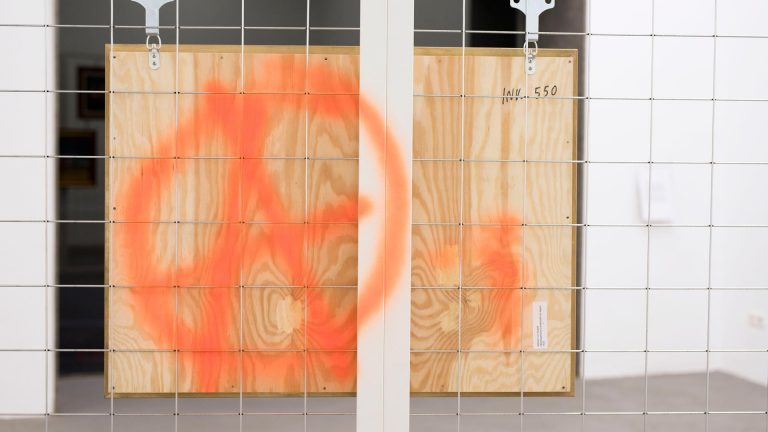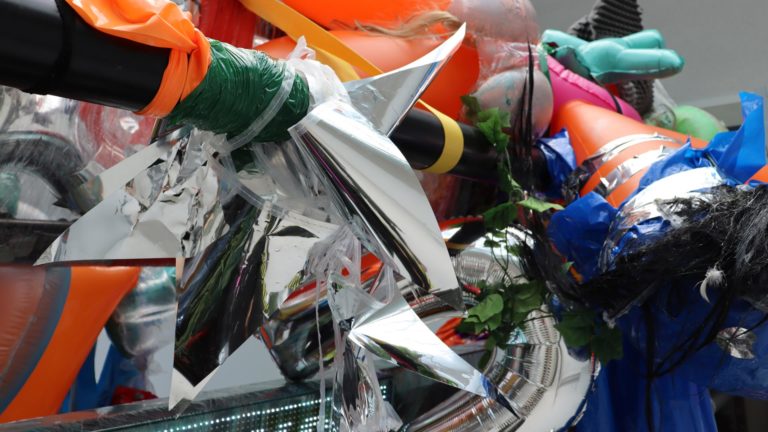Artist: Eliza Ballesteros
Exhibition title: Butcher’s Coin
Curated by: Angela Theisen
Venue: Westfälischer Kunstverein, Münster, Germany
Date: June 25 – September 18, 2022
Photography: all images copyright and courtesy of the artist and Westfälischer Kunstverein
Eliza Ballesteros’s expansive stagings challenge exhibition viewers: her works do not communicate striking or strident messages, but rather offer complex realms of experience that refer associatively to our lifeworld and social milieu. These “staged realities,” as Ballesteros calls her installations, deliberately touch upon a nerve and enable viewers to experience matters and circumstances from unaccustomed perspectives. In her installations, Ballesteros challenges patriarchal power structures, heteronormative role models and social classifications. She dares to “look back into the future” in order to question traditional social systems in the here and now.
In the exhibition BUTCHER’S COIN, commissioned by Westfälischer Kunstverein, Ballesteros taps into the theme of the domestication of animals, which repeatedly serves her as a foil to explore socio-cultural narratives and interpretive sovereignties. To do this, she couples objects from different contexts – the slaughterhouse and the BDSM studio – in order to place them in new relationships. Each of these objects resonates with a key trope in Ballesteros’s work: desire. On a formal level, it is conveyed through her choice of materials. Whether it be the red fabric of the velvet curtain, VEIL/VEAL, the exquisitely-crafted wood of HACK KLOTZ and HACK KLOTZ [pouppée], or the smooth surfaces of TREICHEL I-III, they all share the desire to be experienced haptically. They correspond to other objects made of latex, leather and steel, which can be read variously as an association to forms of pleasure. Harnessed in these objects, the animation of human drives is cogently manifested; these drives – completely in the Hegelian sense – develop commensurately into colossal desire and culminate in fetish.
This desire is also present thematically, that is to say, on the level of content: on the one hand, Ballesteros regards the titular BUTCHER, as a ‘sub,’ i.e. subordinate, who fulfills society’s desire for flesh. On the other, he is master of and executioner to the animal to be slaughtered, i.e. ‘dom’ or dominant. For Ballesteros, the BUTCHER’s profession is the apotheosis of a collective, societal desire, which culminates in killing or destruction. This ambivalent role of the BUTCHER reveals a series of inherent, fluid binaries to her.
In her work, desire and fetishism are thus detached from the private sphere of subjective feeling and acquire socio-political import. Karl Marx had already identified fetishism as a reification of human, social relationships. Thus, in Ballesteros’s work, the killing of animals becomes a metaphor for structurally-anchored hierarchies and dependency relationships in our society. In this way, she puts up for discussion the socio-cultural construction of gender and concomitant categories of power, as well as their associated dynamics, the impact of which should and needs to be exposed time and again. SPIKED COLLARS may serve as a catchy example of this: blow-ups of collars. Taking in the size of a guard dog, they refer to the overriding theme of domestication. Thus, a collar placed on a dog designates the animal as human property. The steel choke chain – as it is sometimes still used on farms today – is a burden to the animal because of its weight. At the same time, however, the spikes offer the guard dog a modicum of protection against predators, making the collar an ambivalent object in its own right.
The starting point for Ballesteros’s reflections on BUTCHER’S COIN was the painting Das Milchmädchen (The Milkmaid), a Biedermeier idyll painted by Adolf Schmidt in 1834, in which neither the domestication of animals nor the labour involved is depicted in a realistic way. The porcelain-like complexion of the milkmaid and her soft hands convey a historical ideal of femininity, not the truth about the circumstances of a hard-working woman on the bottom rung of a farm’s hierarchical ladder. As the farmer’s wife’s helper, a milkmaid’s duties included feeding the cows, mucking out the stalls, milking the cows and subsequently selling the fresh milk. In view of this historical reality, the painting refers to social narratives of the time, which were not geared toward an accurate depiction of a milkmaid’s actual duties – itself a designation that devalues the working woman – but is an expression of an over-stylized type, which was posited during the nineteenth century, solidified itself over time and is a received perception to this day. It is precisely those social and historical constructs of beauty and gender that initially sparked Ballesteros’s interest in this painting.
Central here is the aspect of the viewer’s dominant, desirous gaze on a person – in this instance legible as female and the circumstances of her associated subjugation. The domestication of the animal is understood here as the transferred domestication of the woman and her role. This historically-embedded gaze that continues to shape the objectification of women today, is palpable through Ballesteros’s staging of Das Milchmädchen: in the intimate atmosphere of the display cabinet, THRESHOLD, a curtain – by virtue of the artist’s setting – has to be lifted in an almost voyeuristic manner to reveal Das Milchmädchen and allow the viewer to encounter her in the first place. Surrounded by a KLIMAVITRINE [climate-controlled display case] and KLIMAKISTE [climate-controlled crate], which, according to the artist, act as sentinels, Ballesteros creates a contemporary hortus conclusus through precise settings. Thus, the latex gloves, SLICED GLOVES [cream], obviously refer to the BDSM scene, but at the same time allude to protective gloves worn in the delicate job of handling valuable artworks. They connote the strict regulations that obtain in exhibition practice and logistics, which attach optimum importance to the protection of the artwork. This gesture, developed from the aspect of preservation, at once exposes – in its absoluteness – our fetishistic approach to artworks in general. And it is true: for it is not so much the painting’s artistic merit but more its historical relevance that makes Das Milchmädchen an expressly important object. For it is the first work that the Westfälischer Kunstverein purchased shortly after its establishment and was – at that time – a contemporary work. The painting thus constitutes the material nucleus of the institution’s activities and, as such, a relic of its history. At the same time and via the artist’s subjective approach, the painting has been updated: Ballesteros reads Das Milchmädchen – enshrining the original artist’s stern, almost condescending gaze – as an emancipated person who is answerable to and responsible for herself.
In the interplay of domestication, gender categories and the handling of artworks in a museum context, Ballesteros shows but three aspects of fetish or desire inherent in our society. They exemplify our social milieu, which is, conversely, also constituted by them. As a result, Ballesteros succeeds in radically exposing, mirroring and challenging power structures and their narratives that have developed historically, but which are still perceived as natural, self-evident and permanently set, duly smashing them and thereby calling their legitimacy into question.
BUTCHER’S COIN is Ballesteros’s first institutional solo show and was curated by Angela Theisen.

































